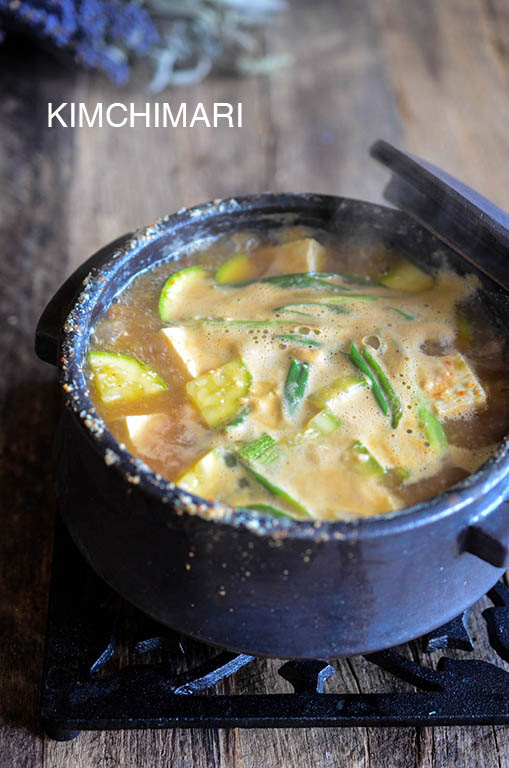
Doenjang Jjigae..I have not yet blogged about this fantastic Korean stew and this is why. It was not on my list of recipes when I first started my Kimchimari Korean food blog because I thought the dish was just too smelly to cook in my daughter’s dorm. Cooking in dorms…that reminds me of my grad school dorm days – 6 students (somehow all Asians) with their own rooms shared a common bathroom and the kitchen. But because kitchen was across the hallway, many times the students made food in their own room with some type of cooking element. I am quite sensitive to smells (people made fun of me when I was little that I had a dog nose) and one of the memories that stand out to me was the all the different food smells I had to endure while I was in the dorm. That’s the first time I realized how offensive one person’s food smell could be to others who are not familiar with it.
It would be so lovely if everyone could love the smell of Doenjang Jjigae much like the smell of pizza or apple pie, but sadly it has a very unique odor that is pretty strong. Doenjang Jjigae is such a comfort food for Koreans that I think most Koreans love the smell. And it brings all sorts of pleasant memories to us, a smell that tells you that you are almost home …with each Doenjang Jjigae smell having a different signature as unique as the people cooking them. Some Koreans make a simple Doenjang Jjigae without any meat but just vegetables and tofu, some make it with a fatty beef cut like chadolbaegi (second cut of brisket) and some make it with lots of seafood like clams and shrimp.
Now doenjang comes in a whole spectrum of different colors, going from the lighter brown color to the very dark, almost black color. The older the doenjang, the darker the color will be. Anyway, more on how to make and how to buy doenjang in my next “Know your Doenjang” post.
So my Doenjang Jjigae recipe has evolved over the years. When I first started making it as a newlywed, I made it with onions and white mushrooms and thought it was pretty good. Because, for some reason, this was not a dish that we made often at home when I was growing up or maybe I just don’t have a good recollection of it. So I learned it from the local Korean restaurants in Florida. Restaurants always add onions and mushrooms and tofu. The jjigae was kind of sweet and mushroomy which I thought was OK…
But then when I had my mother-in-law’s Doenjang Jjigae, the depth of flavor was just incomparable. I could taste the doenjang much more and not so much of the other ingredients. And that’s when I learned that you should NOT add onions to Doenjang Jjigae if you want to keep the aroma and flavor of doenjang. Strong flavored mushrooms also do the same thing. They often overpower the doenjang. Mild mushrooms like oyster or king mushrooms are fine. But if you like a sweeter and smoother tasting jjigae, you might like to add onions. And finally, I use rice water (water obtained from rinsing rice) for the base of the broth. The rice water makes the broth more smooth tasting and also keeps the doenjang from separating from the broth.
Anyway, let’s get started, shall we??
Servings: 2-3 Prep: 10 min Cooking: 25 min Difficulty: Easy
Ingredients
- 2 T + 1 tsp doenjang (adjust to taste)
- 3 cups rice water or water (쌀뜨물 Ssal Tteu Mul)
- 1 handful dried large anchovies (국멸치 Guk Myeolchi) for stock (see my K Ingredients page)
- 1 piece (2 in square) dried kelp (다시마 Dashima) for broth
- 1 small grey squash or zucchini
- 1/2 pack of 14 oz extra firm tofu (firm or even soft is OK)
- 1 tsp chopped garlic
- 1/2 tsp red chili pepper powder (gochukaru)
- 1 green onion, sliced
- 1 green chili pepper (optional)
Optionally you may want to have –
- Korean ttukbaegi (뚝배기) – Clay hot pot made with special Korean pottery technique that keeps it water tight but at the same time lets the pot breath. Something about this kind of pot makes your jjigae SO TASTY! I’m not sure exactly why but it does. Also, one thing to note about these ttukbaegi/ddukbaegi is that you should NOT use any detergent when washing them because the micro air pockets will absorb the detergent when you wash them. Just soak in warm water if you need to.
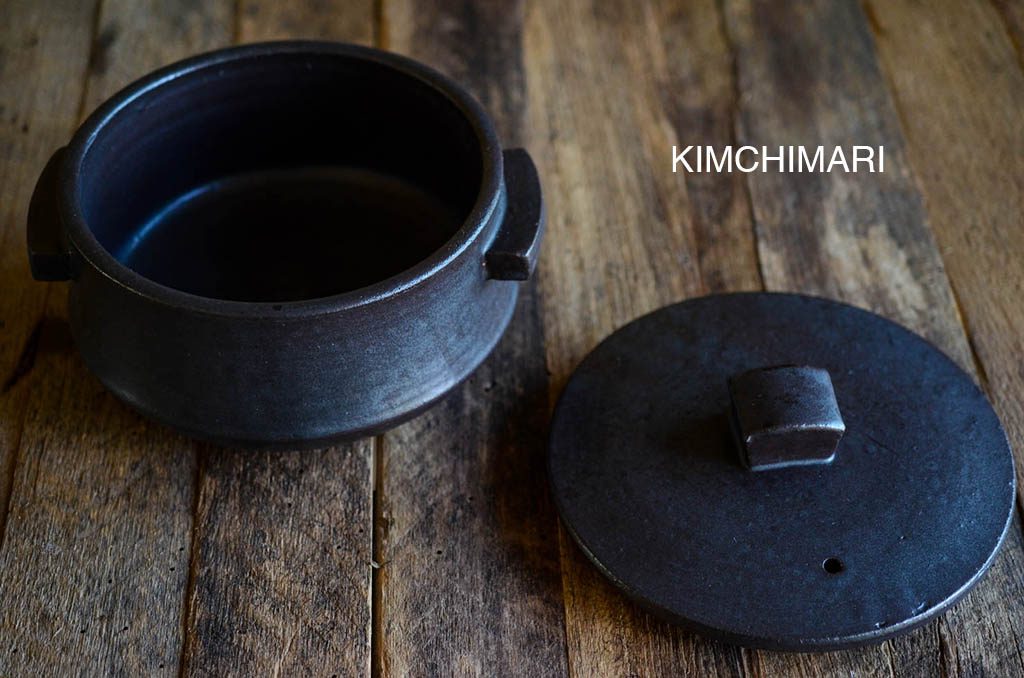
Korean Clay Hot Pot (뚝배기 ttukbaegi)
So let’s get cooking!
- Start by saving 3 cups rice water when rinsing rice. Discard water from at least the 1st rinse. You may want to rinse about 2-3 times before saving the rice water.
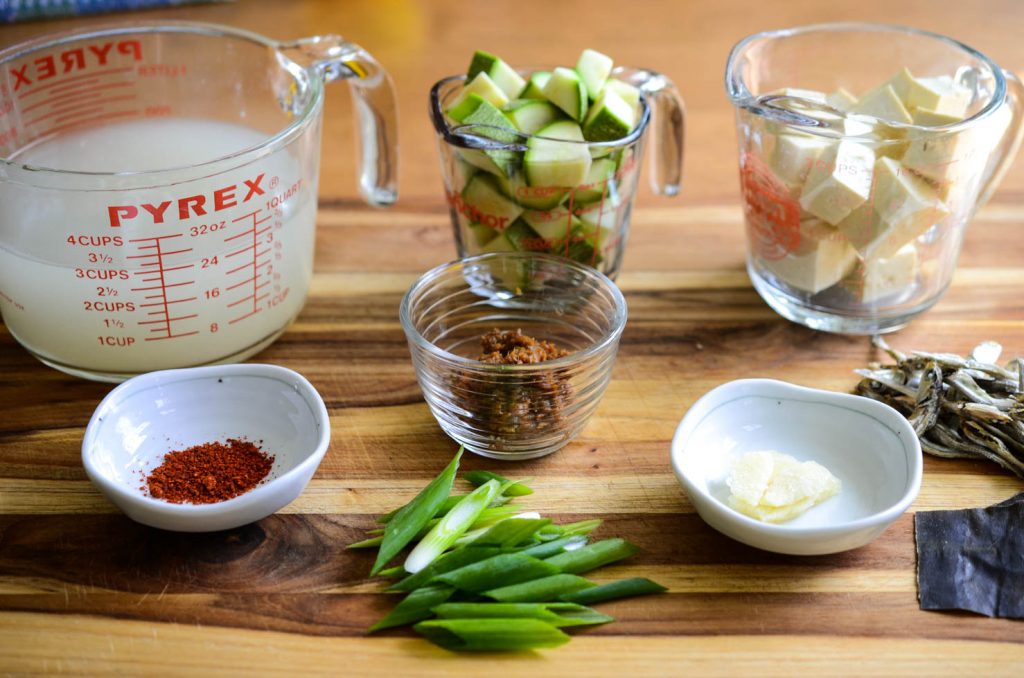
Doenjang Jjigae ingredients - Prepare other ingredients: cut tofu and squash into 1/2 in thick x 1 in pieces, slice green onion and chop garlic. Also some red chili pepper powder, doenjang, dried anchovies and dried kelp.
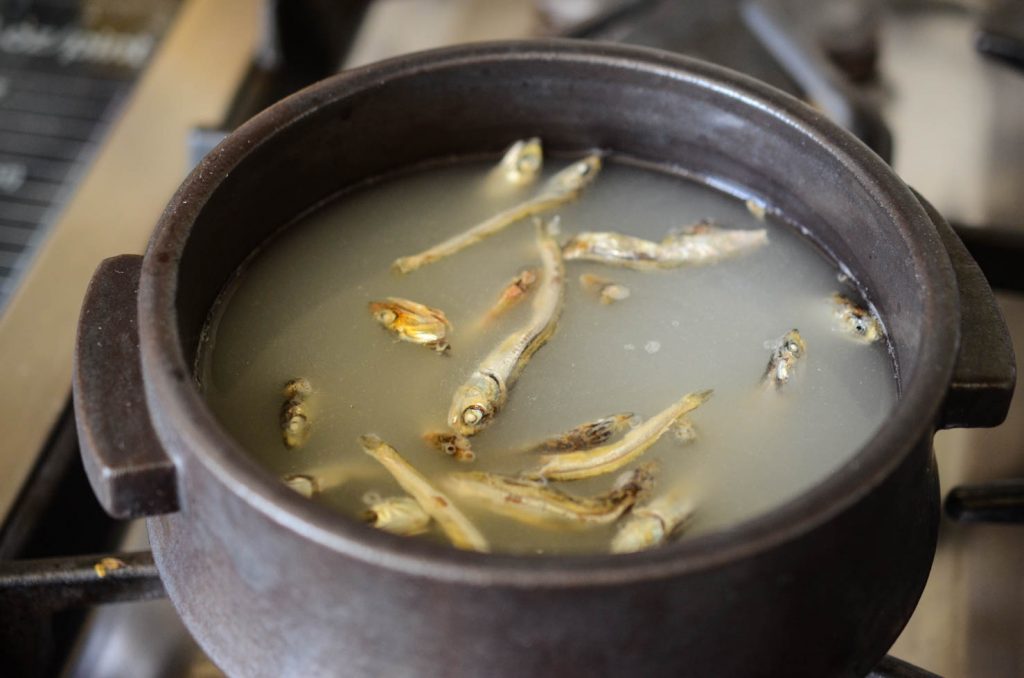
- Add dried soup anchovies and kelp to rice water. I don’t take out the gut of my anchovies for making stock, you are welcome to do it but it doesn’t make much difference here because we are making a very small batch and will be taking out the anchovies quickly. Simmer on medium heat for 10 min.
- Discard anchovies and kelp. To make it easier, you can use those dashi tea bags but I just use one of those Chinese spider strainers. It may not get out every little bits but that’s OK.
- Turn off heat and mix in doenjang. Easy way to mix doenjang is to smoosh it against the wall of your pot.
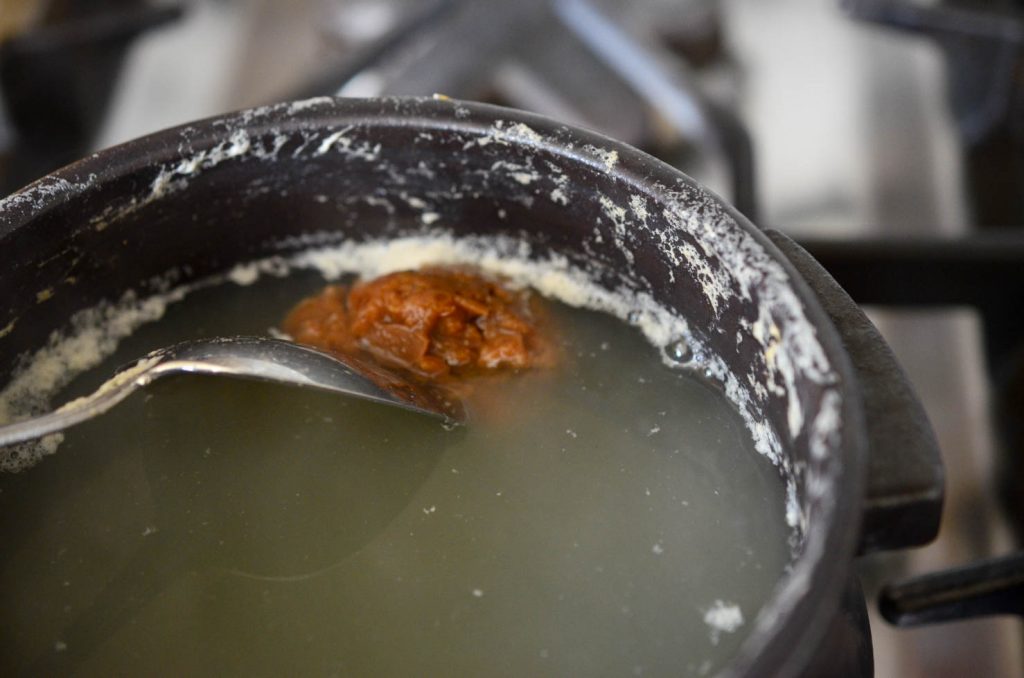
Mixing Deonjang in rice water - Turn heat to medium high and bring to doenjang broth to boil.
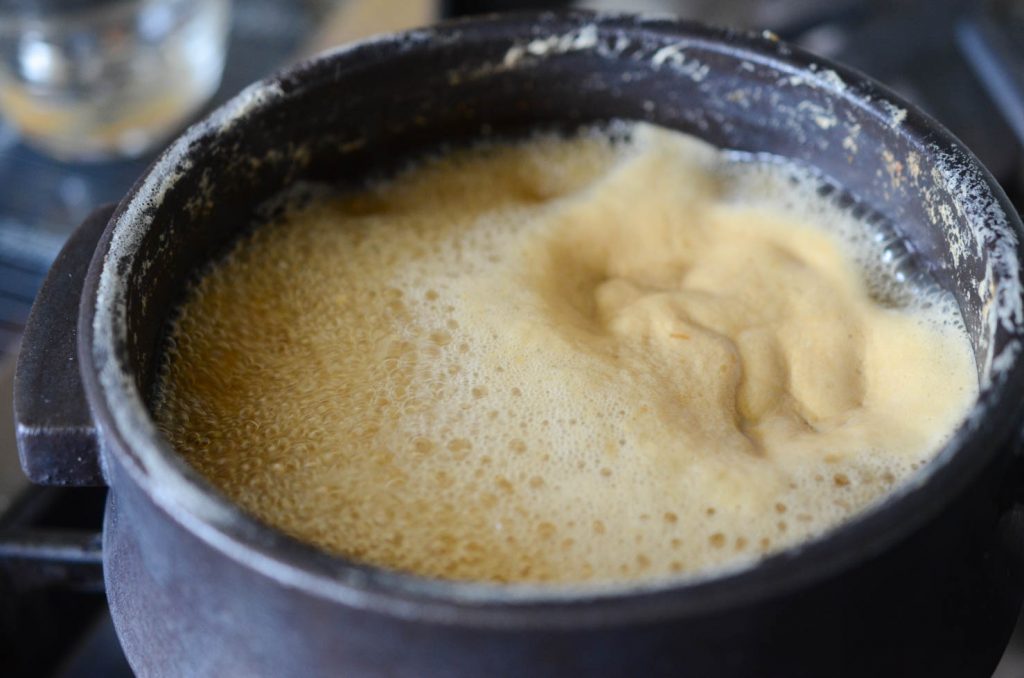
Doenjang Jjigae broth boiling - Add squash or zucchini. Boil for 5 min.
- Add tofu and boil for another 5 min.
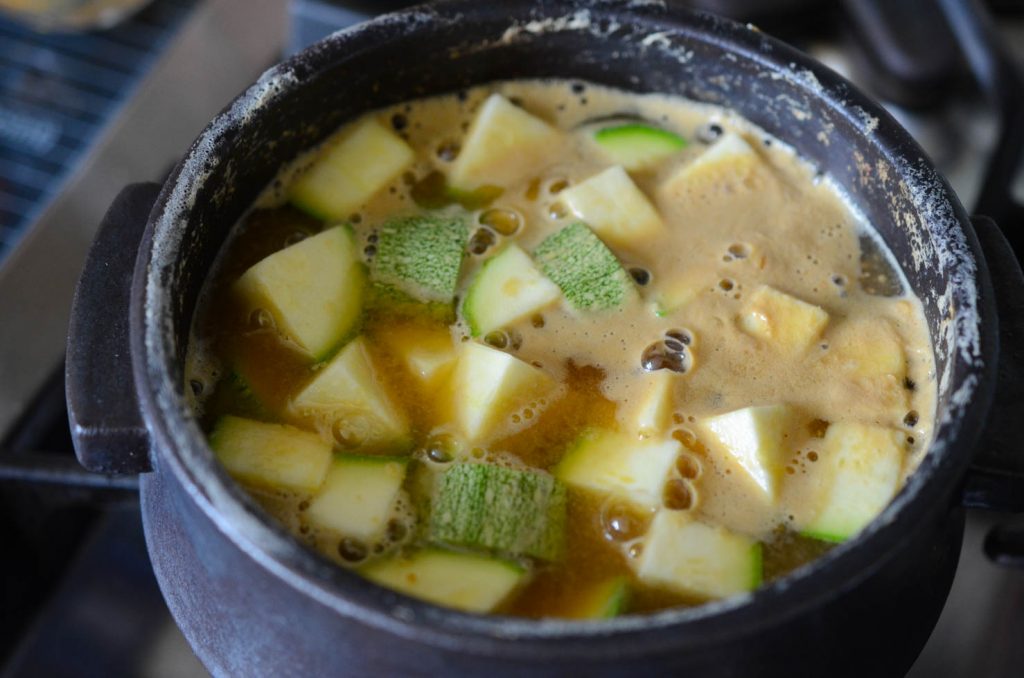
Tofu and Squash added to Soybean Paste Stew - Add green onions and chopped garlic. Boil for 3 more minutes.
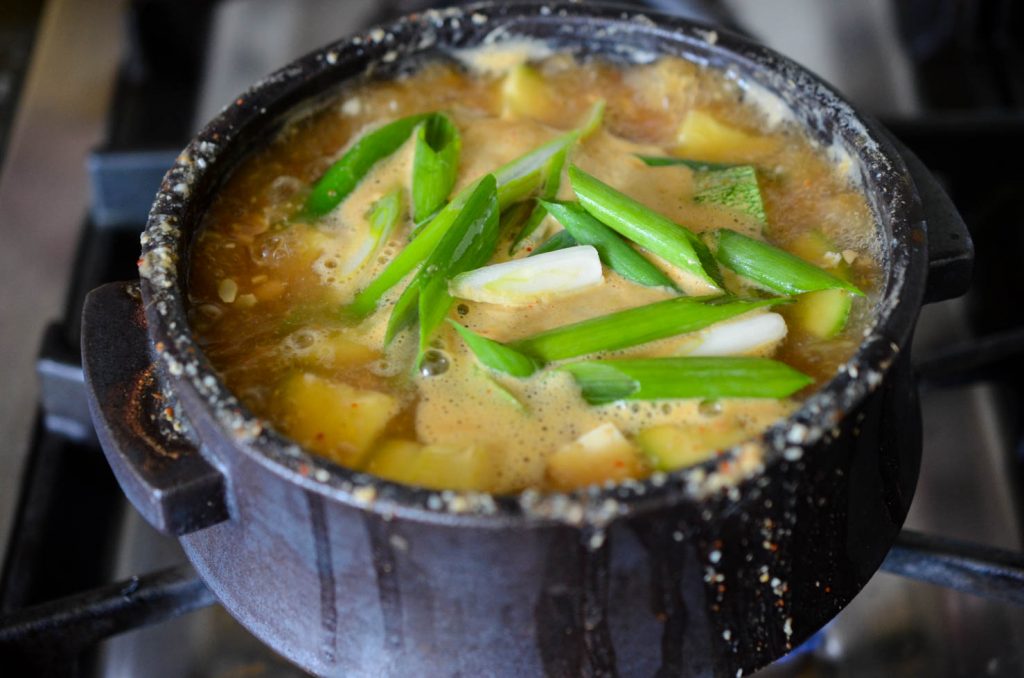
Doenjang Jjigae finished with green onions and garlic added - Sprinkle with red chili pepper. And SERVE!
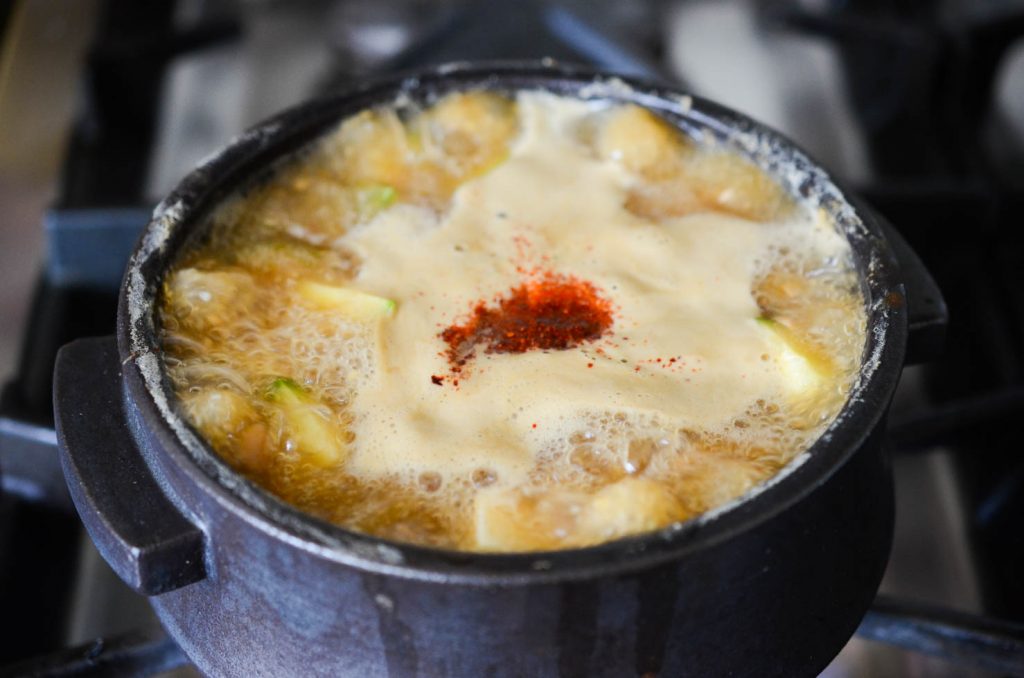
DoenjangJjigae bubbling and boiling like crazy! 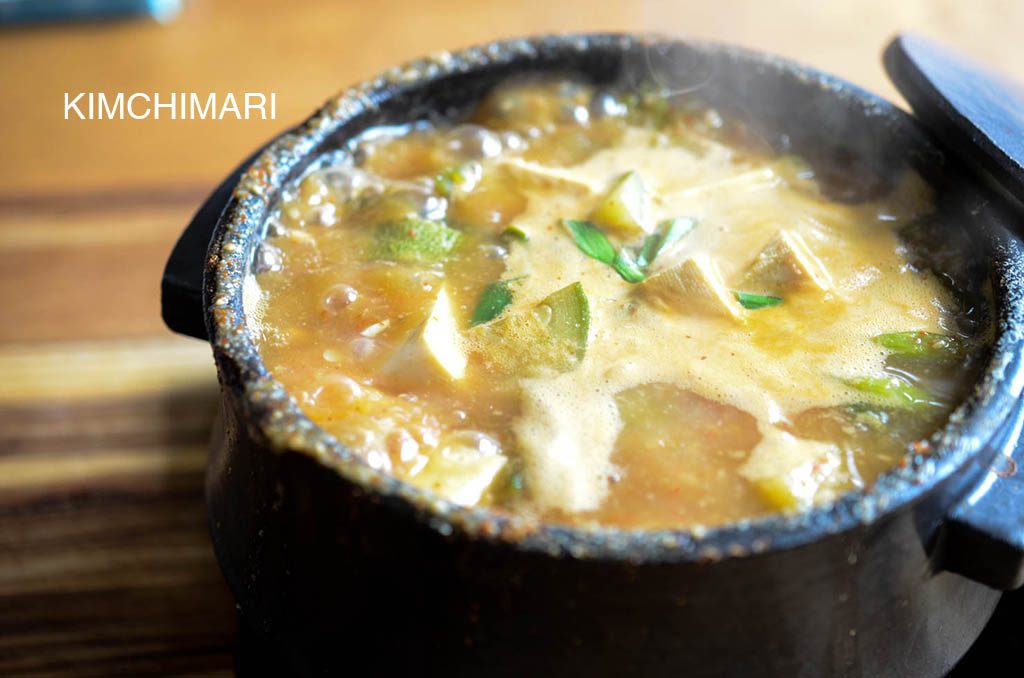
Korean Soy Bean Paste Stew boiling in Ttukbaegi 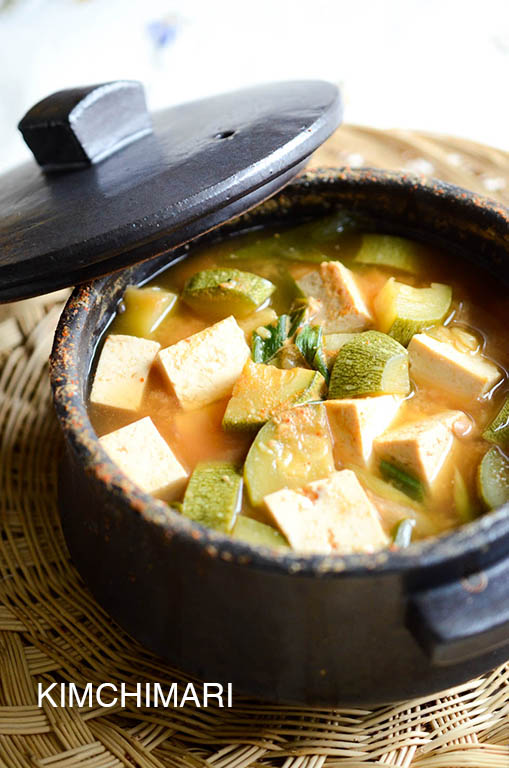
Doenjang Jjigae in Ttukbaegi, much calmer after boiling like crazy! 🙂 Doenjang Jjigae (Korean soybean paste stew)
The most uniquely delicious Korean stew made with fermented soybean paste (Doenjang). Fabulous with Korean BBQ and Jeon!Prep: 10 minutesCook: 25 minutesTotal Time: 35 minutesserves: 2Ingredients
- 2 Tbsp + 1 tsp Doenjang (adjust to taste)
- 3 cups rice water or water (쌀뜨물 Ssal Tteu Mul)
- 1 handful dried anchovies (국멸치 Guk Myeolchi) for stock (see my K Ingredients page)
- 1 piece (2 in square) dried kelp (다시마 Dashima) for broth
- 1 small grey squash or zucchini
- 1/2 pack of 14 oz extra firm tofu (firm or even soft is OK)
- 1 tsp chopped garlic
- 1/2 tsp red chili pepper (gochukaru)
- 1 green onions , sliced
- 1 green chili pepper (optional)
Instructions
- Start by saving 3 cups rice water when rinsing rice.
- Cut tofu and squash into squares, slice green onions and chop garlic. Also slice green onions.
- Add dried soup anchovies and kelp to rice water. Simmer on medium heat for 10 min.
- Discard anchovies and kelp.
- Turn off heat and mix in doenjang. Easy way to mix doenjang is to smoosh it against the wall of your pot.
- Turn heat to medium high and bring to boil.
- Add squash or zucchini squares. Boil for 5 min.
- Add tofu squares and boil for another 5 min.
- Add green onions and chopped garlic. Boil for 3 more minutes.
- Sprinkle with red chili pepper. And SERVE!
Tips & Notes:
Do NOT add garlic too early, that will make the doenjang jjigae taste bitter.
The uses for this rice water is many in Korean culture including washing dishes and washing your face.
Serve with rice and kimchi. Goes perfectly well with Korean BBQs, Pajeon or any kind of Jeon like Zucchini fritters.Nutrition Information:
Calories: 111kcal (6%)| Carbohydrates: 13g (4%)| Protein: 10g (20%)| Fat: 2g (3%)| Sodium: 533mg (23%)| Potassium: 408mg (12%)| Fiber: 2g (8%)| Sugar: 7g (8%)| Vitamin A: 255IU (5%)| Vitamin C: 24mg (29%)| Calcium: 46mg (5%)| Iron: 1.8mg (10%)
Extras
- Add beef stew meat for more richer Doenjang Jjigae
- Add all sorts of seafood (clams, shrimp, squid, abalone..) to make Haemul Doenjang Jjigae (해물된장찌게)
- Ssal Tteu Mul (쌀뜨물) – Since Koreans eat a lot of rice, the water obtained while rinsing the rice has its own name! The uses for this rice water are many in Korean culture, including washing dishes and washing your face. 🙂
- Do NOT add garlic too early, it can make the doenjang jjigae taste bitter.
Serving Suggestions
- Serve with rice and kimchi. Goes perfectly well with Korean BBQs, Pajeon or any kind of Jeon like Zucchini fritters.
Enjoy the aroma!!!
JinJoo
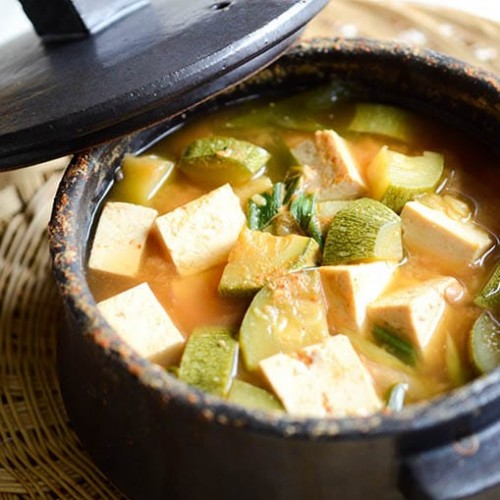
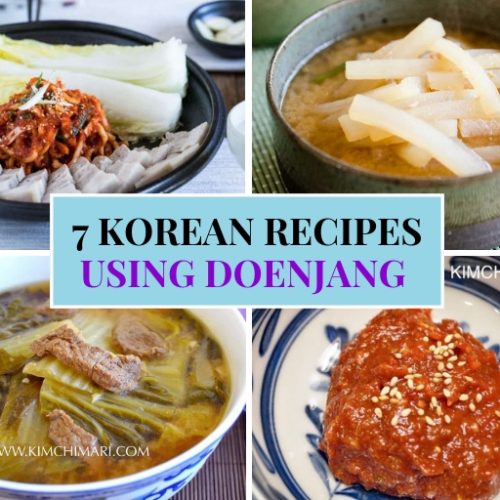
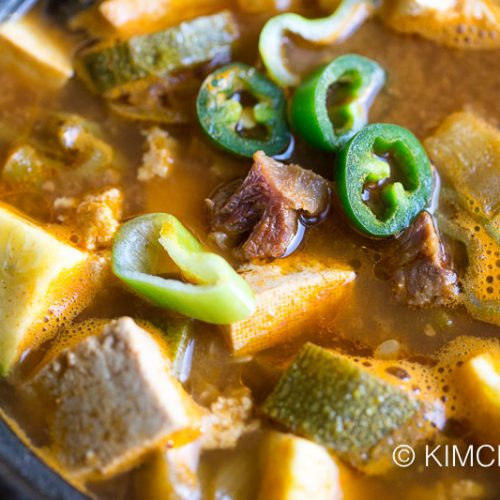
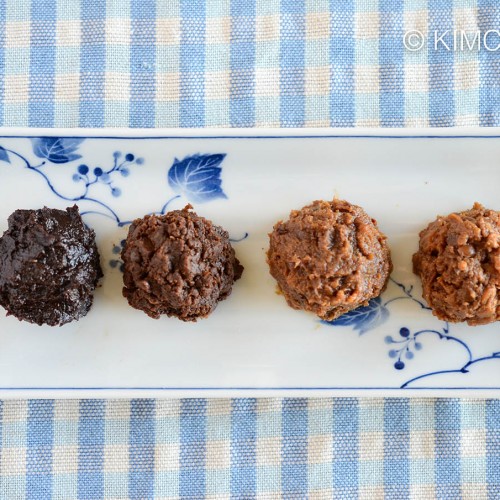
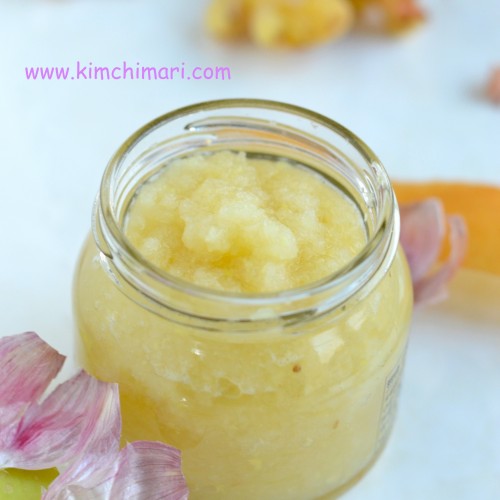
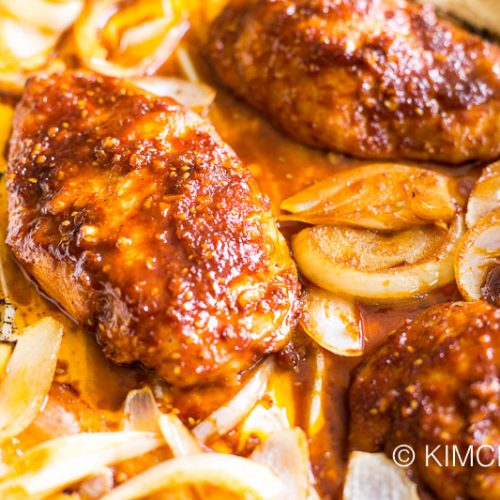
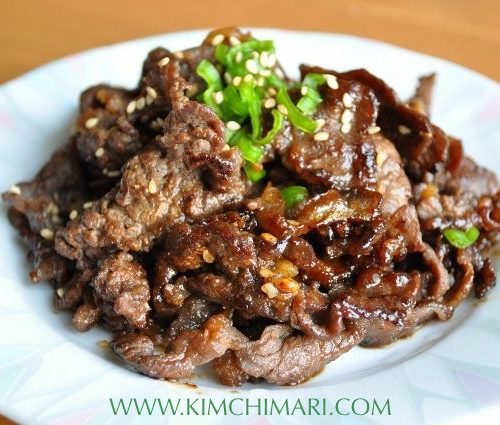
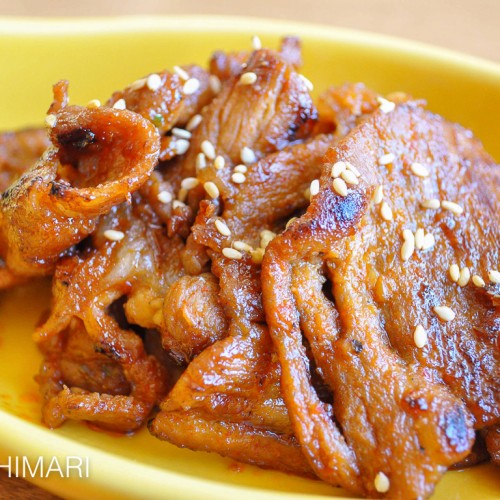

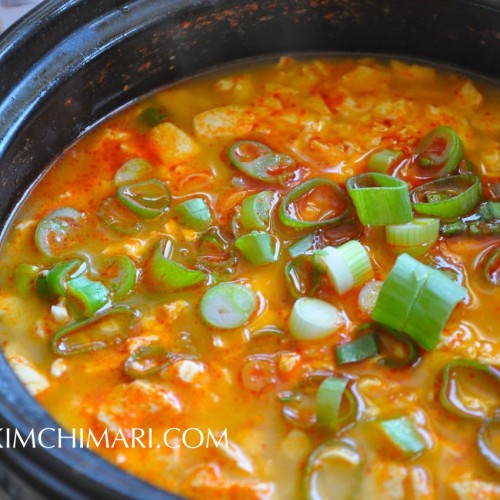
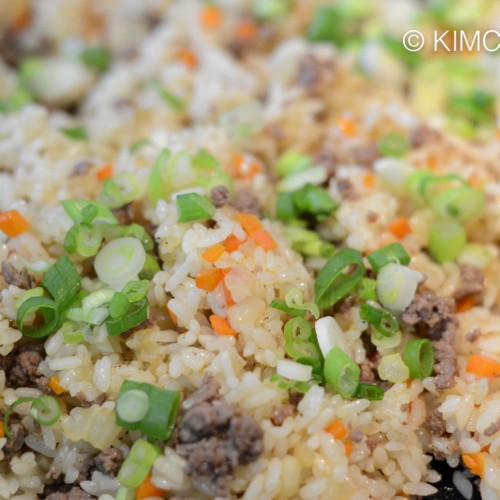
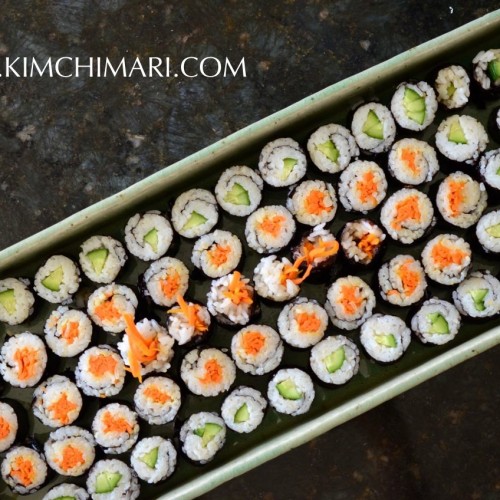
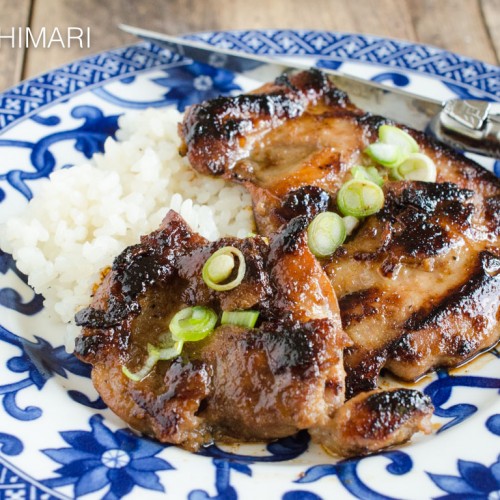
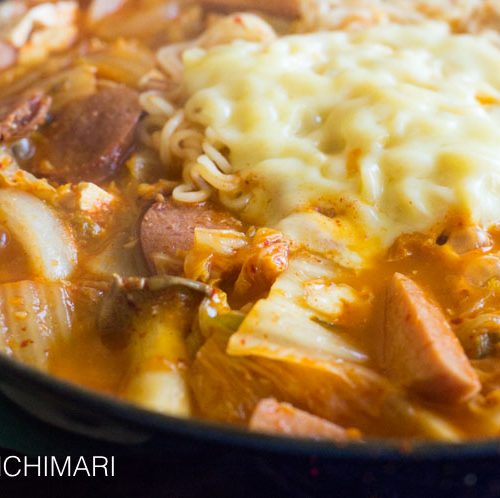
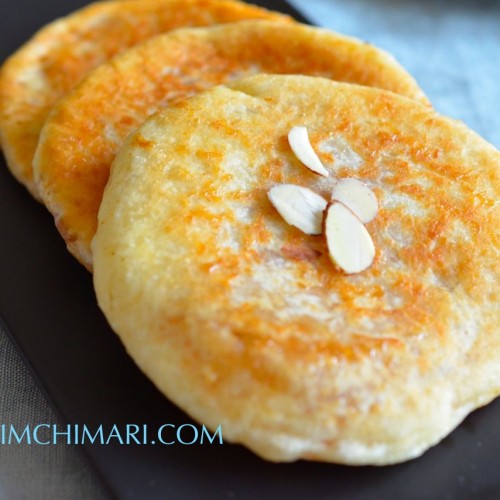






Is it possible to use beef broth, or would you advise against that?
Of course! Beef broth makes it yummy too. It makes it taste richer. You can even use leftover uncooked marinated kalbi ribs (you know like if you go to a Korean BBQ restaurant and you have the bone part leftover) and it comes out delicious. Thank you for asking!
Is it possible to use some kind of vegetable instead of anchovies or to just leave them out? I love your Doenjang Jjigae and would like to share it with my friends. Since some of them are vegans I want to make one that everyone can enjoy.
Sure, they can try making a vegetable broth by simmering sea kelp (다시마 dashima) and radish in water for 20-30 min until you get a tasty broth. Normally it’s good to also add dried shitake mushrooms to the veg broth but I’m not sure if that will work against the Doenjang. If they like mushroom flavor and don’t mind the doenjang flavor/aroma becoming somewhat lessened, they are welcome to try adding shitake mushrooms. Thanks so much for asking and also for sharing. :)) Don’t hesitate to ask more questions! PS – They can also still use rice water to have a richer broth.
I never heard of using rice water for soup base. I am very interested in trying it out. Would you please elaborate on this? How many times do you wash the rice before using the water? Do you soak the rice in water for certain amount of time? Do you use this water for any other soup? The reason I am asking is because I was told that there is certain amount of arsenic in rice. You need to wash the rice several times in order to minimize the arsenic. I love this soup. I have told to anyone who asks “what would be your last meal if I can pick” – that it would be doenjang jjigae. So anything I can do to improve would be great.
HI! Wow thanks so much for asking!! I was going to mention about using at least the 2nd rinse or even 3/4th rinse but forgot!! And I will write a separate post about the rice water but your question is quite important so I will answer here first. I’m also going to add to my post. So, the common advice is to use water from the 2nd or 3rd rinse since the 1st water will probably wash out dust and other things. But if you are concerned about the arsenic, you can try washing couple times more and then use the water. Although the water will probably become clearer…Rice water can be used for Siraegi Doenjang guk and even Kimchi jjigae. I also heard that it can be used to reduce fishy smell when making Mackerel Jorim but I have not tried it. I’m sure it will be fine. Thanks so much for asking!
Do you leave the anchovies and kelp in the stew or take them out before you add the Doenjang.
OH THANK YOU and bless you for asking!! Yes, you should take both the anchovies and kelp out before you add Doenjang. I totally missed that step. I added it in now. Thank you again for pointing it out. Have a great day!!
My mother in law prefers doen jang that is homemade, but sometimes I find it too pungent.
Are there any commercial brands of doen jang that you recommend that are earthy and delicious, without tasting mass produced?
Hi! So that was going to be part of my next post but one brand I found that is sold in my local market in the US is Yangpyeong Doenjang 양평된장. It is not too salty not too strong and no MSG. I don’t think is mass produced. Hopefully you can find it. Thanks for asking!
Oh and if you cannot find Yangpyeong brand, Sempio brand doenjang that I have selected in my Amazon store should be good. Because they contain authentic ingredients…good luck!